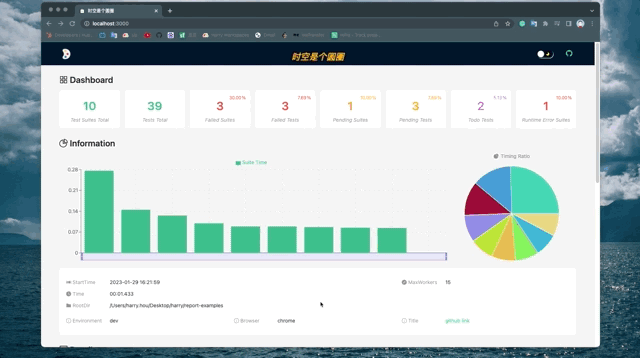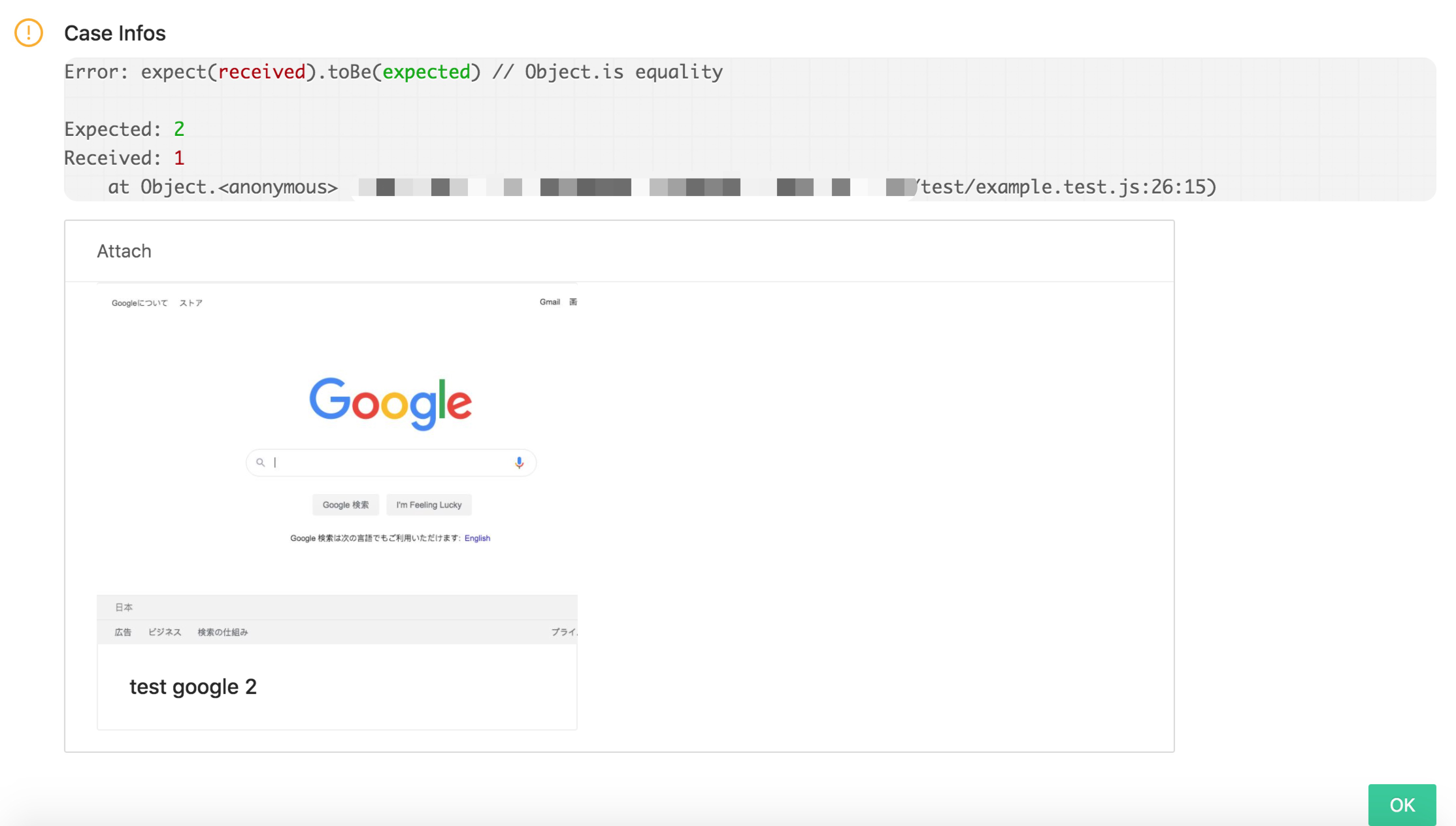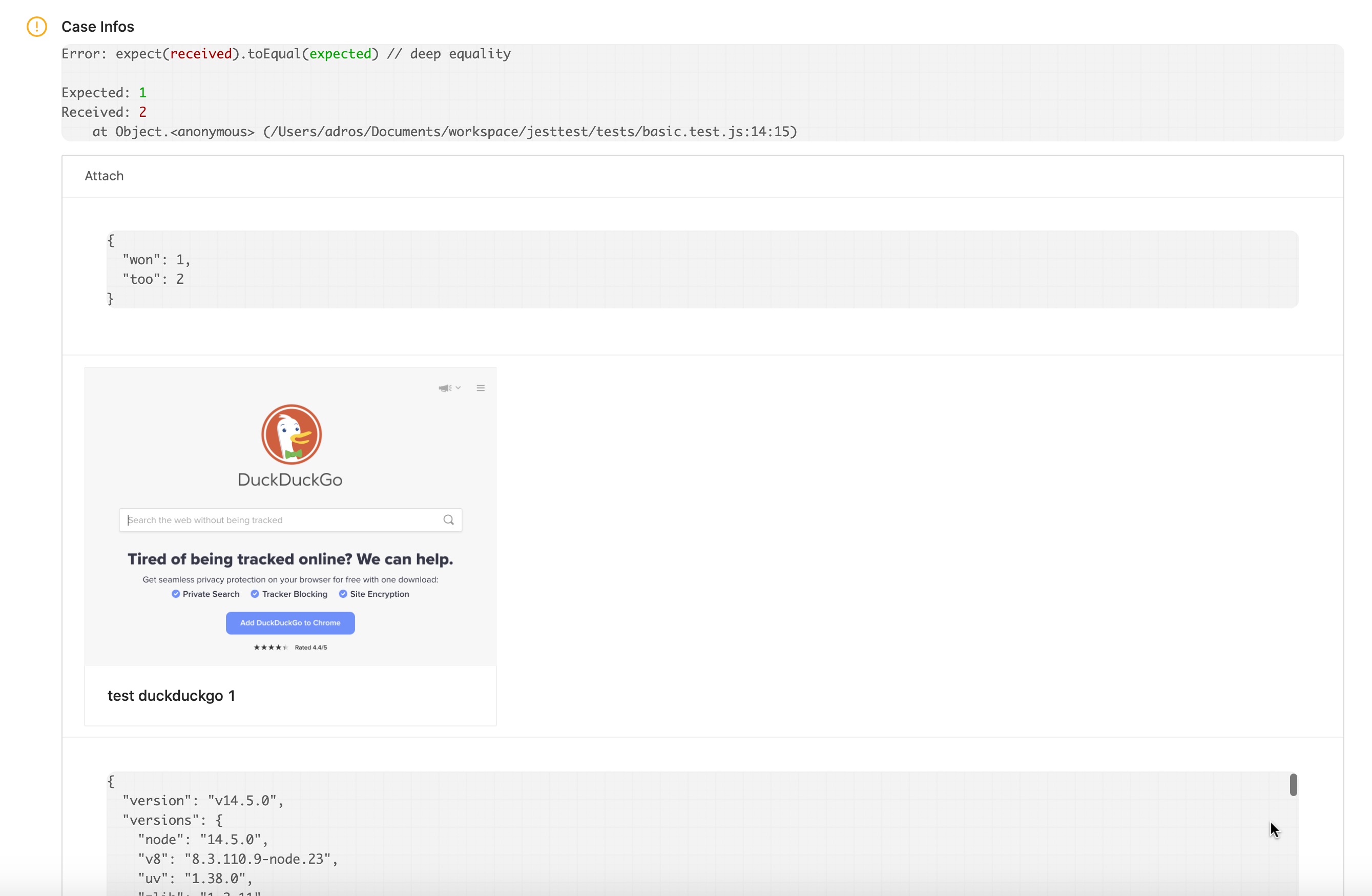Jest reporter
English | 简体中文
Jest test results processor for generating a summary in HTML
Example page https://hazyzh.github.io/report.html
Installation
# yarn
yarn add jest-html-reporters --dev
# npm
npm install jest-html-reporters --save-devUsage
Configure Jest to process the test results by adding the following entry to the Jest config (jest.config.json):
"jest": {
...,
"reporters": [
"default",
"jest-html-reporters"
],
...
}
As you run Jest from within the terminal, a file called jest_html_reporters.html will be created within your root folder containing information about your tests.
Available Options
The options below are specific to the reporter.
| Option Name | Type | Default | Description | env variables name |
|---|---|---|---|---|
publicPath |
string | '' | specify the base path | JEST_HTML_REPORTERS_PUBLIC_PATH |
filename |
string | jest_html_reporters.html | Filename of saved report Applies to the generated html |
JEST_HTML_REPORTERS_FILE_NAME |
includeConsoleLog |
boolean | false | set true to display console logs for each test suite. NOTE: the precondition is to run Jest with --verbose=false in order to catch all logs during the tests. |
JEST_HTML_REPORTERS_INCLUDE_CONSOLE_LOG |
darkTheme |
boolean | false | set true to generate dark theme report page |
JEST_HTML_REPORTERS_DARK_THEME |
failureMessageOnly |
number | 0 |
0 : always create report. 1 : show failure test suites messages only in Report. 2 : only create report when some test suites failed. |
JEST_HTML_REPORTERS_FAILURE_MESSAGE_ONLY |
inlineSource |
boolean | false | Option to save report in a single combined HTML file #184 | JEST_HTML_REPORTERS_INLINE_SOURCE |
pageTitle |
string | Report | specify header and page title | JEST_HTML_REPORTERS_PAGE_TITLE |
logoImgPath |
string | undefined | specify path of the image that will be displayed to the right of page title | JEST_HTML_REPORTERS_LOGO_IMG_PATH |
hideIcon |
boolean | false | hide default icon | JEST_HTML_REPORTERS_HIDE_ICON |
expand |
boolean | false | specify whether default expand all data | JEST_HTML_REPORTERS_EXPAND |
testCommand |
string | "" | copy command content to quickly run test file | JEST_HTML_REPORTERS_TEST_COMMAND |
openReport |
boolean | in dev=true, rest=false | options for npm package open
|
JEST_HTML_REPORTERS_OPEN_REPORT |
urlForTestFiles |
string | '' | url for test files. If user set this value, Details table shows an icon link to each rows. The link is constructed by joining urlForTestFiles and relativePath (like /src/utils/index.test.js) for each tests. See the detail in #221
|
JEST_HTML_REPORTERS_URL_FOR_TEST_FILES |
customInfos |
array | undefined | show some custom data info in the report, example value [ {title: 'test1', value: 'test1'}, {title: 'test2', value: 'test2'}], you can also set value to a environment variable JEST_HTML_REPORTERS_CUSTOM_INFOS, see detail in #32
|
JEST_HTML_REPORTERS_CUSTOM_INFOS |
enableMergeData |
boolean | false | for default enable merge test data feature | JEST_HTML_REPORTERS_ENABLE_MERGE_DATA |
dataMergeLevel |
number | 1 | default merge test data level | JEST_HTML_REPORTERS_DATA_MERGE_LEVEL |
env only |
string | system default temporary directory | path to a temporary folder with attachments | JEST_HTML_REPORTERS_TEMP_DIR_PATH |
stripSkippedTest |
boolean | false | skip the pending tests and suites in the final report | JEST_HTML_REPORTERS_STRIP_SKIPPED_TEST |
example add config options
...,
"reporters": [
"default",
["jest-html-reporters", {
"publicPath": "./html-report",
"filename": "report.html",
"openReport": true
}]
]some features.
- Collapsable Test Groups
This feature regrading to #37, if a test file has many test cases, here will show a Merge Data checkbox on the expanded table. You can check it to merge data and set the merge level to control how to combine those data.
- Attach screenshot to report
This feature regrading to #36, this package will a new method named addAttach.
interface IAddAttachParams {
attach: string | Buffer;
description: string | object;
context: any;
bufferFormat: string;
}
There are three params of this method, description is easy to understand. The param attach referring to the image, you can pass a buffer or string, if it was a buffer the package will help you create a dir named jest-html-reporters-attach and save that buffer as a jpg image in it under the publicPath. if you have already saved the image, just pass the image's path as the attach param.
context is an optional parameter. Here can be specified context (default is this.global).
Here is an Example with puppeteer.
// Example attach with **buffer**
const { addAttach } = require("jest-html-reporters/helper");
const puppeteer = require("puppeteer");
describe("just examples", () => {
test("test buffer", async () => {
const browser = await puppeteer.launch();
const page = await browser.newPage();
await page.goto("https://www.google.com");
const data = await page.screenshot();
await browser.close();
await addAttach({
attach: data,
description: 'img 1',
});
await addAttach({
attach: await fs.readFileSync('./test.mp4'),
description: 'img 1',
bufferFormat: 'mp4',
});
expect(1).toBe(1);
});
});// Example attach with **string**
const { addAttach } = require("jest-html-reporters/helper");
const puppeteer = require("puppeteer");
const path = require("path");
describe("just examples", () => {
test("case string", async () => {
const filePath = path.resolve(__dirname, "./test.jpg");
await browser.close();
await addAttach({
attach: filePath,
description: 'test google 2',
});
await addAttach({
attach: 'www.example.com/test.mp4',
description: 'test video 2',
});
expect(1).toBe(2);
});
});- Attach a message to the report
This feature is in regards to #63 & #64. It allows you to add a message or log something to the html report with addMsg()
/**
* @param {object} options - options object
* @param {string | object} options.message - message string
* @param {any} [options.context] - custom context (optional)
*/
const addMsg = async ({ message, context }) => { ... }
Only one parameter is required. If you pass an serializable object like, it will auth using JSON.stringify(object, null, 2) to save the object and then prettified it in report.
context is an optional parameter. Here can be specified context (default is this.global).
Here is an Example with Nightmare.
const { addAttach, addMsg } = require("jest-html-reporters/helper");
const Nightmare = require("nightmare");
describe("Yet another example", () => {
test("Both addAttach & addMsg with failure", async () => {
const nightmare = Nightmare({ show: true });
await addMsg({ message: { won: 1, too: 2 } });
await nightmare.goto("https://duckduckgo.com");
const s1 = await nightmare.screenshot();
await addAttach(s1, "test duckduckgo 1");
await nightmare.end();
await addMsg({ message: JSON.stringify(process, null, 2) });
expect(2).toEqual(1);
}, 20000);
test("addMsg with success", async () => {
await addMsg({ message: JSON.stringify({ free: 3, for: 4 }, null, 2) });
expect(2).toEqual(2);
});
});Message still displays without screenshots and with a successful test

- Show a link for each test file
If user set some value to urlForTestFiles, Details table shows an icon link to each rows. The link is constructed by joining urlForTestFiles (ex: https://github.com/Hazyzh/jest-html-reporters/blob/master) and relativePath (ex: /src/utils/index.test.js) for each tests.








